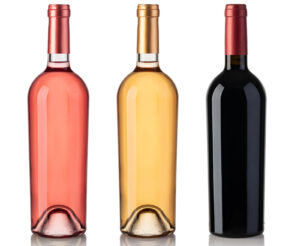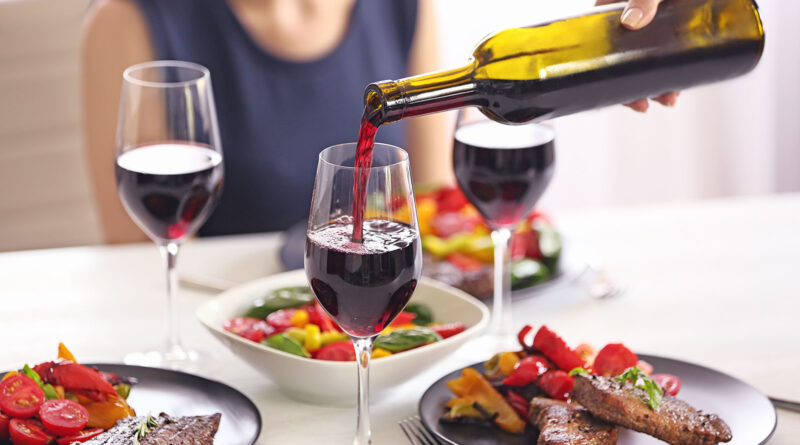Red, white or rosé?
Simple food & wine pairings for a great meal when dining in or out
By Janna Zepp
You’re planning an elegant dinner, whether for a party of two or a party of eight, and you want the perfect wine to go with your meal. Or you are out to dinner at a posh restaurant and the server asks what wine you’d like with dinner. But what you know about wine boils down to red wines go with red meats and white wines go with white meats. You instinctively know there’s more to food and wine pairings than just that simple statement. There must be because you don’t care for red wine, but you love red meat. What do you do?
First, don’t panic. Second, take heart: You CAN drink white wine with red meat after all. How is this possible? Pairings are more complex and yet easier to do than you might think.
Certified Sommelier Glenn Boswell of Wineshark.com owns and runs a traveling comedy wine education food and wine pairing show all over Texas, including Bell County, in which he buys all the food and wine, comes to your home, cooks, cleans up and educates dinner parties of 10 people privately. He says good quality wines do not have to be expensive. In fact, he says that if you pay more than $25-$30 for a wine, you’re buying the label more than the libation.
“What you are really looking for, more than a label or a particular vineyard, is something that doesn’t obliterate your wallet and does make your meal a complete experience,” Boswell says. His food and wine pairing education presentations include the basics of pairings you will learn about here.
A great pairing creates a balance between the courses of a dish and the characteristics of a wine. As much as pairing food and wine is complex, the basics are simple to grasp.
Tips For Pairing Wine & Food
If you’re just getting started, you’ll find these methods will help you produce consistently great pairings. As you get more familiar with different wines, you’ll become confident and can experiment with breaking the rules.
- The wine should be more acidic than the food.
- The wine should be sweeter than the food.
- The wine should have the same flavor intensity as the food.
- Red wines pair best with bold flavored meats (e.g. red meat).
- White wines pair best with light-intensity meats (e.g. fish or poultry).
- Bitter wines (e.g. red wines) are best balanced with fat.
- It is better to match the wine with the sauce than with the meat.
- White, sparkling and rosé wines often create contrasting pairings while red wines often create compatible pairings. A contrasting pairing creates balance between tastes and flavors. A compatible pairing boosts shared flavor compounds.
Identify Basic Tastes
You only need to focus on six tastes when pairing food and wine: salty, acidic, sweet, bitter, fat and spicy.

Basic taste components in wine
For the most part, wine lacks the three tastes of fatness, spiciness and saltiness but does contain acidity, sweetness and bitterness in varying degrees. Generally speaking, you can group wines into three categories:
- Red wines have more “bitterness” caused by tannins.
- White, rosé and sparkling wines have more acidity.
- Sweet wines have more sweetness.
Basic taste components in food
Simplify a dish down to its basic dominant tastes. For example, baked macaroni has two primary components: fat and salt. Southern barbecue is a bit more complex and includes fat, salt, sweet and spicy (and some acid). Even dishes without meat can be simplified. For example, a green salad offers acidity and bitterness; creamed corn offers fatness and sweetness.
Consider the Intensity
FOOD: Is the food light or rich? A salad might seem lighter, but maybe the dressing is balsamic vinaigrette which has high acidity. If the intensity of the dish isn’t obvious at first, just focus on the power of each taste component (acidity, fat, sweet, etc.).
WINE: Is the wine light or bold? Here are a few examples:
- Sauvignon Blanc is light-bodied, but it has higher acidity
- Chardonnay has more body, but it’s usually not too acidic
- Pinot Noir is lighter bodied (for a red wine) and it doesn’t have too much tannin (bitterness).
- Cabernet Sauvignon is more full-bodied and has high tannin count (more bitterness)
Find Contrasting or Compatible Pairings
Now that you’ve identified all the basic taste components in your dish, you can start playing around with pairing options. The simple example of the baked macaroni will offer several possible pairings:
COMPLEMENTARY PAIRING: A white wine with high acidity will complement the fat in the macaroni. So, for example, a traditional mac and cheese recipe with a creamy béchamel sauce matched with zesty white wine such as Pinot Grigio, Assyrtiko or Sauvignon Blanc would create a complementary pairing.
COMPATIBLE PAIRING: A white wine with creaminess will add to the creaminess in the dish. So, for example, a traditional mac and cheese recipe with a creamy béchamel sauce matched with a creamy white wine such as Viognier or Chardonnay would create a compatible pairing.
Getting Creative
Once you create balance with the major taste features in both the wine and the dish, you can get creative by pairing the more subtle flavors. Here are some examples using variants of mac and cheese:
BOLD RED WINE: The high bitterness (tannin) will be balanced out by the salt and fat in the macaroni. This balancing will leave you with the remaining subtle flavors to pair within the cheese and wine. So, for example, if your baked macaroni has smoked gouda in it, you might choose a Shiraz, which also has smokiness in it on the finish. The smoky flavors combine to create a compatible pairing while the tannin in the wine creates a complementary pairing with the fat in the dish.
SWEET WHITE WINE: This brings out the sweet and salty flavors with a pairing. For example, a mac and cheese with ham would match well with a zesty white wine with some sweetness like Riesling. The acidity would create a complementary pairing to the fat and the sweetness would act as a compatible pairing to the ham. Pork is considered red meat, even though it has been erroneously described as “the other white meat.”
One more thing you should know, according to Boswell: how to hold your wine glass the proper way.
“Do not grasp your wine goblet by the bowl like some ancient barbarian king. Hold it by the stem. The stem exists on the glass to keep your hands off the wine so that it does not affect the temperature by making your wine too warm. Every time you hold the wine glass by the bowl, an (exotic dancer) falls off her pole. Stop hurting her,” he says without skipping a beat in his presentation.
Boswell also says, regarding wine temperatures, that we Americans (he’s one too, so he can say it) serve our wines either too warm or too cold.
“We serve our white wines too cold and our reds too warm. Room temperature in the U.S. is far warmer than it is in Europe,” he explains. “The optimum temperature for wine is in a range between about 45°F to 65°F if there is not a large change in temperature each day.”
Boswell also says there are wine documentaries you can watch to further your education. He particularly recommends the film, Somm.
Directed by Jason Wise, Somm is a 2012 American documentary following the attempts of four candidates to pass the extremely difficult Master Sommelier examination, a test with one of the lowest pass rates in the world.
“The film is exceptionally well done and makes its subject matter accessible to those who are not experts in wine,” Boswell says. “Too often, wine is shrouded in ceremony, circumstance, and complexity. Wine can be approachable and accessible to almost any budget. From grocery to luxury, wine has a place.”




